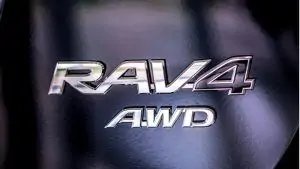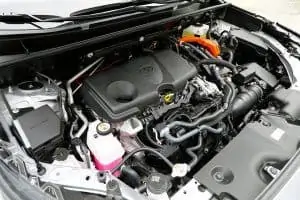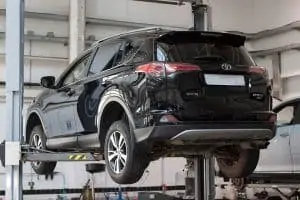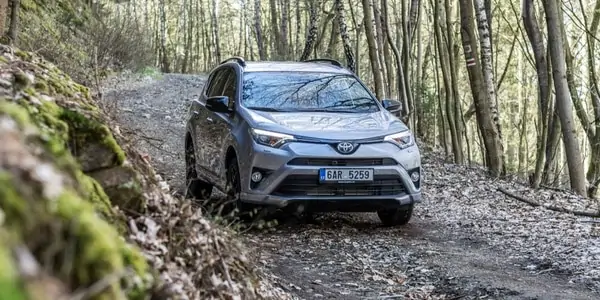The RAV4 – Toyota’s Best Seller
Highlighting the Best Year for the Toyota RAV4 + RAV4 Years to Avoid
Over the past twenty years, we’ve seen a shift of consumer’s buying preferences as it relates to car shopping. American consumers are opting for crossover SUVs when given the choice, hence the rise of the compact crossover. You’ll notice that parking lots across the nation are dominated by crossovers. Why?
The crossover is usually more affordable than a traditional SUV. They are smaller and easier to get around in, have better fuel economy, lower sticker prices, are stylish and can be quite zippy depending on the engine size. For consumers who need something bigger than a car, but not looking to go as big as a traditional SUV, and don’t want to drive around in a minivan, the crossover is a great option!
The Toyota RAV4 is Toyota’s compact crossover and it’s no surprise that in the past few years it has become Toyota’s best seller, outselling every Toyota model, including the popular Camry
Let’s take a closer look at Toyota’s bestseller, the RAV4. If you’re shopping for a compact crossover, the RAV4 may be a great option to consider. We’ll look at the best model years for the Toyota RAV4 and Toyota RAV4 years you will either want to avoid or pay extra attention to some of the known issues we list below so you can have them addressed.
If you are considering buying a used car that has under 140,000 miles and is a 2012 model or newer, get a free quote for one of our "extended car warranty solutions".
100% Online, 9 Coverage Options and No Robocalls!
The RAV4
Toyota offers many RAV4 trims for every type of consumer. Whether you’re looking for a budget-friendly option or opting for some luxury or even some outdoorsy fun, there are plenty of choices. According to the Toyota website, the 2021 RAV4 is offered in 11 different trims, from the base model LE to the plush Limited version and everything in between to take you from luxe to adventure. Want some off-roading thrills? No problem, there’s even a TRD Off Road option. So while the RAV4 may be considered the automaker’s smaller SUV, the options are not small, no way!
The RAV4 has a long list of standard features, including Apple CarPlay, Android Auto, a user-friendly infotainment system with a 7-inch touch screen. Standard safety features include lane keep assist, lane departure and trace assist, which keeps the vehicle centered in the lane, even on curved roads. Also included are forward collision warning, automatic emergency braking and pedestrian detection. The RAV4 comes with a 2.5-liter four-cylinder engine and an eight-speed automatic transmission. Front-wheel drive is standard but all-wheel drive is optional on the LE, XLE, XLE Premium and Limited, and standard on the Adventure and TRD Off-Road models. Taking cues from other Toyota legends, like the Tacoma and the 4Runner, the RAV4 front-end design is rugged and stylish. Because it is a crossover, it looks like a smaller SUV, but drives smoother than both the Tacoma or 4Runner. It is a well-rounded crossover with a roomy cabin, made with quality materials. It’s fuel efficient, but yet can deliver power too. Below are the starting MSRP for the different RAV4 trims.
- LE $26,050 LE Hybrid $28,500
- XLE $27,345 XLE Hybrid $29,795
- XLE Premium $30,050 XLE Premium Hybrid $32,500
- Limited $34,580 Limited Hybrid $37,030
- Adventure $33, 155
- TRD Off-Road $35,780
- XSE Hybrid $34, 450
Raving Reliability
Toyota has built a reputation for producing reliable cars and SUVs, so as you would expect, the RAV4 comes with raving reliability scores. According to RepairPal, the Toyota RAV4 earned a 4 out of 5 stars on the firm’s Reliability Rating scale, which makes it 3rd best out of 26 compact SUVs. When compared to other vehicles in general, the RAV4 has excellent ownership costs with repairs being less severe and less frequent than other compact SUVs and vehicles overall, making it one of the most reliable vehicles on road.
On other reliability scales, the RAV4’s reliability scores are consistent with that of RepairPal’s. Using Consumer Reports’ data, the RAV4’s decadelong average reliability came in at an impressive 4.5 out of 5, and a 4.1 when we averaged its scores over the past 20 years! So the legendary Toyota reliability does not waver when it comes to the RAV4.
The average annual repair cost is $429, compared to an average of $521 for other compact SUVs. The frequency you can anticipate visiting a repair shop is low too and comparable to its classmates. Toyota RAV4 owners have to bring their vehicles to a repair shop for unscheduled repairs an average of .3 times per year, compared to an average of .4 for all other vehicle types. When it comes to severe repairs, you’ll be pleased to know that the probability of a repair being major is about 10%, so not urgent. Other SUVs in its class average 11%.
While repairing a Toyota RAV4 can be less expensive than other brands, you could still come across a hefty repair bill at some point, so we recommend adding additional coverage through a mechanic al breakdown insurance provider (MBI), or a vehicle services contract (VSC). These are often referred to as an extended car warranty. A MBI or VSC can help take the sting out of an unexpected repair and give you peace of mind. olive® is a trusted name in the MBI and VSC industry and specializes in vehicle extended warranty solutions for consumers. You can see if your car qualifies, get 9 different coverage and pricing options and even buy and manage online if you want to at shop.olive.com.
Maintenance Costs

Top 5 RAV4 Problems
Although the RAV4 is a great compact SUV and has proven to be reliable, owners have had some challenges with some model years. Here are the most commonly reported problems as reported to RepairPal, as well as the associated average cost of the repair.
Faulty EVAP Vapor Canister – The vapor canister has been reported to plug/clog the vent valve because it releases charcoal pellets resulting in a fault code of either P0441, P0442 or P0446, which is the primary code associated with this fail and an electrical failure. Proper repair involves replacing the entire canister with all the valves as a unit. Unfortunately, this repair can be expensive as it is located on top of the fuel tank. Model years affected: 1996-2016 with an owner reported cost of about $1,000 to $1,500. Average mileage: 106,403.
False Catalytic Converter Failure – Owners reported the Check Engine Light would illuminate pointing to a bad catalytic converter. The issue ended up being a software issue, which Toyota remedied by upgrading the software to correct the false “bad catalytic converter” message. This affected second and third generation model years 1996 and 2001-2007. Average mileage: 149,044. The average cost to diagnose the Check Engine Light is between $88 and $111.
Failed Oxygen Sensor
The Check Engine light comes on when one or more of the oxygen sensors fails, resulting in reduced fuel economy, rough idling or a hesitant engine that possibly skips or misfires. Other symptoms include a ‘rotten egg’ smell or black smoke coming from the exhaust. Model years affected: 1998, 2001 – 2003, 2006-2012, 2014 at an average mileage of 247,047. The average cost to replace the RAV4 oxygen sensor is anywhere between $275 and $297.
Transmission Shifting Issues – At higher mileage the automatic transmission may not shift correctly, which may be caused by the throttle position sensor being out of alignment or a shift solenoid needing to be replaced. Ten model years were specifically affected with this shifting issue: 1996, 1997, 2000-2008 at an average mileage of 133,569.
This was corroborated by the carcomplaints.com website, which lists transmission issues as the worst problem for the RAV4. The worst model years in terms of transmission complaints are 2002 (368 complaints), 2001 (180 complaints), and 2003 (120 complaints). To fix transmission problems, plan around $2,400 and occur around 70,000 miles on average depending on the specific transmission issue.
Excessive Oil Consumption – Drivers noticed excessive oil consumption between oil changes. Many times, the loss of oil was drastic, causing the engine oil warning light to display. Usually this problem occurs when the vehicles’ oil is not changed frequently, however this problem has been reported consistently for a few model years, specifically those in the third generation. Owners said their RAV4’s engine would burn lots of oil causing them to add more oil more than once per month. The vehicle’s engine should be cleaned of oil sludge, but if the excessive oil consumption continues, the vehicle may require new piston rings. Five model years were affected, 2004-2008 at an average mileage of 121,285.
What is the Best Year for the Toyota RAV4?
As we’ve mentioned before, the RAV4 has demonstrated that it is a reliable compact SUV, so when looking to determine the “best,” it was quite challenging, considering the fourth generation model years have near perfect reliability. But we sorted through the data and have decided; The 2016 model year is the “best” Toyota RAV4 and worthy of your hard-earned cash. Here’s why:
The 2016 Toyota RAV4 earned a perfect reliability score from Consumer Reports and when it was put to the test, literally, by J. D. Power, it came up on top, beating out model years 2017 and 2018 by just a smidge. So while our “best” RAV4 is the 2016, you really can’t go wrong with the newer two years, 2017 or 2018.
The 2016 earned an overall score of 86 based on the J.D. Power 100-Point Score, which is based on thousands of unbiased opinions of verified owners. Overall it ranked #1 in the J.D. Power Top 10 Rated SUV list comparing similar compact SUVs, beating out the likes of Honda, Nissan, Mazda and other popular brands, like Chevy and Ford.
For quality and reliability, it scored an 86, boasting a “great” for its driving experience and “best” score of 91 for its resale value. The 2016 Toyota RAV4 was also the winner of the J.D. Power Performance Award for its design and performance after the first 90 days of ownership. While the 2016 has more complaints than the 2018 model year, it’s also two years older and the most common complaints fell within the interior accessories category, specifically the cruise control function.
The 2016 model years are ranging in price from $15,000 to just under $20,000.
Pro-Tip: If you purchase an older Toyota RAV4, it’s wise to consider a MBI or VSC for your your Toyota from shop.olive.com/.
Toyota RAV4 Years to Avoid?
While the Toyota RAV4 is generally a very reliable car, If you look at the RAV4’s history, there are a few years you might want to avoid, or get thoroughly checked out before purchasing. In fact, we recommend you get any previously owned vehicle checked out before you buy it.
This information is not meant to discourage you from buying a Toyota RAV4, but to give you the information you need to make the right buying decision. Sometimes you can get a great deal on a particular year of RAV4 because they may be a bit more difficult to sell, and if you can make sure the issue is addressed or use it as a negotiation point you may be able to buy with peace of mind and save some money over another model year.
We’ll start with the latest generation and work our way back because while older RAV4s are still on the market, it is more likely that consumers looking for a used one, will be looking for one less than 10 years old.
5th Generation (2019 + present) – For being a fairly newer model you wouldn’t expect it to be on our “avoid” list, especially since Toyota is known for its reliability, but the 2019 has some issues you should make certain you are aware of and address. Over the past 20 years, not only does the 2019 model have the lowest reliability score of 2 out of 5 from Consumer Reports, but it also has quite a few complaints already. And the complaints being reported are not cosmetic either, they affect the transmission and engine components. In the 2019 RAV4, owners have experienced gear slippage, hesitating or lurching forward at slower speeds, loud acceleration and a faulty gas gauge that some owners have said does not read the amount of gas correctly, so you never know how much gas is actually in the tank. One owner noted that the tank never seems to read more than three quarter’s full. If you’re after a newer model RAV4, the 2018 would be our choice.
4th Generation (2013 – 2018) – Overall the 4th generation produced some great RAV4s, but for the purposes of this exercise, we’d suggest avoiding the RAV4 model year 2013. While it had a reliability rating of 5, it is the year that experienced the most complaints, with the worst complaint being a major safety issue. Owners noted that their RAV4 would suddenly accelerate and would not stop even after pressing the brakes. Owners reported accidents, which resulted in the deployment of the air bags and in some cases a total loss of the vehicle. For this reason alone, 2013 is not a safe bet.
If you’re set on an older RAV4, consider other model years that are part of the fourth generation, like model years 2017, 2016 or even 2012.
3rd Generation (2006 – 2012) – The 2008 RAV4 also has a few issues you will want to have addressed, or avoid and consider getting another model year that is likely a bit more reliable. . There may be better options for the price and with far less complaints. Toyota has been making the RAV4s since 1994, spanning five generations, and out of all its model years and gens, the 2008 was labeled as the “Worst” model year ever from carcomplaints.com. In looking at the data, we couldn’t agree more. carcomplaints.com, m.
Model years 2006 through 2008 had a high number of complaints annually and the issues
#1 Excessive oil consumption | average cost to fix: $3,300
#2 Air bags did not deploy | average cost to fix: $3,000
#3 Transmission Jerking | average cost to fix: $900
Get Peace of Mind – Invest in an olive® Extended Warranty
We know Toyota is known for its reliability, but what happens when they prove otherwise? Just like with any vehicle, no matter how well crafted, items eventually break down. olive® wants you to prepare for the unexpected and not break your wallet in the process. Get peace of mind to back your ride.
In many cases, vehicle warranties expire after the first three years or 36,000 miles, so it’s a good idea to consider a Mechanical Breakdown Insurance plan or a Vehicle Service Contract ready in case of an unfortunate breakdown. With olive®, you’re covered, and you can get a quote online easily and be protected the very next day.
Our products, customer service and reputation for excellence have earned us an A+ rating with the Better Business Bureau, and we have partnered with some of the insurance industry’s largest companies to back us. With olive®, we’ll be your reliable partner, in the event your vehicle isn’t. Here are some of the benefits you can look forward to:
No waiting period
Start coverage up to 140,000 miles
No yearly mileage limits
Coverage across the U.S.
Manageable monthly payment options
Cancel anytime



